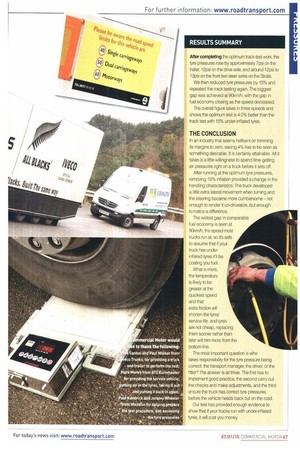RESULTS SUMMARY
Page 47

If you've noticed an error in this article please click here to report it so we can fix it.
After completing the optimum track-test work, the tyre pressures rose by approximately 7psi on the trailer 12psi on the drive axle, and around 12psi to 13psi on the front two steer axles on the Stralis.
We then reduced tyre pressures by 15% and repeated the track testing again. The biggest gap was achieved at 90km/h, with the gap in fuel economy closing as the speed decreased.
The overall figure takes in three speeds and shows the optimum test is 4.0% better than the track test with 15% under-inflated tyres.
THE CONCLUSION
In an industry that seems hellbent on trimming its margins to zero, saving 4% has to be seen as something desirable. It is certainly attainable. All it takes is a little willingness to spend time getting air pressures right on a truck before it sets off.
After running at the optimum tyre pressures, removing 15% inflation provided a change in the handling characteristics. The truck developed a little extra lateral movement when turning and the steering became more cumbersome — not enough to render it un-driveable, but enough to notice a difference.
The widest gap in comparable fuel economy is seen at 90km/h, the speed most trucks run at, so its safe to assume that if your truck has underinflated tyres it'll be costing you fuel.
What is more, the temperature is likely to be greater at the quickest speed and that extra friction will shorten the tyres' service life, and tyres are not cheap, replacing them sooner rather than later will trim more from the bottom line.
The most important question is who takes responsibility for the tyre pressure being correct: the transport manager, the driver, or the fitter? The answer is all three. The first has to implement good practice, the second carry out the checks and make adjustments, and the third ensure the truck has correct tyre pressures before the vehicle heads back out on the road.
Our test has provided enough evidence to show that if your trucks run with under-inflated tyres, it will cost you money.




























































































































